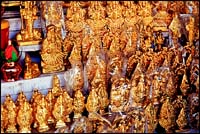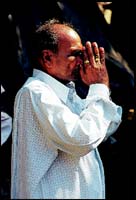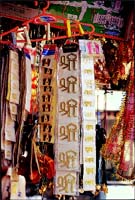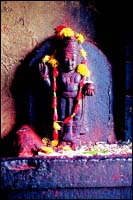


|
|
|
TEMPLES are wonderful places. They leave me with a sense of well-being, of fulfilment, they offer me the opportunity of achieving peace and stability in the course of a working day. They are like a one-stop shop for God to me. I like visiting temples big and small, old and new, and of different faiths and orders. The presiding deity of the temple is not a matter of great importance to me. I am not going into a temple for the sake of worship, only. I am going for the sake of being there. I go for the sheer intrinsic value of the temple and what it does to me. I am thrilled to hear the sound of temple bells, a loud and clamourous jangling, as compared to the sonorous pealing of church bells. Or, in the stillness of the day, a single, deep and resonant �tong� as some worshipper hits the bell hard to attract the attention of the perhaps-sleeping God. Truly, the sound of worship is the sound of bells.
I shoot pictures of such scenes. God and man caught in candid camera. No takes or retakes, just what I see through my lens� eye. The rich industrialist begging God for more of what he�s already got plenty of. The beggar thanking God for the day�s meal that some charitable devotee just fed him. I shoot old people and young, rich and poor, VIPs and the common man. All one and the same when bowed in supplication before God. Is it their desperate need that draws them there? Or gratitude for mercies granted already? I don�t know. I go, because temples draw me to them.
In Kolhapur, where Shakti the Goddess of Power is so strongly manifested, I have spent an entire awe-struck morning at the Mahalakshmi Temple whose architecture dates back to the Chalukya reign of around 600 to 700 A.D. It is an amazing temple and full of good, spiritual vibrations. The idol of the Goddess here is made of gemstone. It weighs about 40 kilos and is said to be at least 5,000 years old. A stone lion stands guard behind this statue. The Goddess has four limbs. The head has a crown and the Sheshnag (the mythical serpent of Shri Vishnu) is on it.
What is unique about the Goddess of the Mahalakshmi Temple is that whereas the idols of God face the north or the east directions, this idol faces the west. A small window on the western wall of the temple attracts the rays of the sun once a year during sunset and they fall directly on the face of the idol as if the sun is paying homage to Goddess Mahalakshmi. This is not surprising because human life itself is said to revolve around illumination and prosperity. What is surprising is the amazing architecture of the temple that allows this to happen. That the rays of the setting sun should bow at the feet of Goddess Mahalakshmi from through a window. This special event is celebrated as Kiran Utsav and it happens only thrice a year, for three days each time.
Everywhere you go in the Mahalakshmi temple, you can hear bells. The ghantanaad, or ringing of temple bells, begins at 4 a.m. every day and the closing bells are sounded round about 11.30 p.m. And you can hear pipes blowing and drums beating. It is a sound that comes from somewhere high up where musicians sit playing to the Gods and to the devotees visiting the temple. I took darshan of all the smaller shrines at Kolhapur�s Mahalakshmi temple, I bought flowers from one of the colourful stalls, and prasad from a small little counter meant for the purpose. I shot the beggars, the vendors and the priests. And when I was leaving, an orderly queue of school-children holding out their hands for the prasad.
|

Home Page
About the mag
Subscribe
Advertise
Contact Us

 The Mahalakshmi Temple Abode Of The Goddess Of Power
The Mahalakshmi Temple Abode Of The Goddess Of Power
 I marvel also at the architecture of temples. At how man in centuries gone by, when there was no science and technology, no communications to rely on, could embark on the construction of such marvellous edifices purely on his own enterprise and ingenuity. Design, form, structure, the material used, these all leave me with a sense of wonderment. And I get lost in the pursuit of all this. I wander in and out of temples, by myself, accompanied by some friendly priest or informative keeper, studying people and their one-to-one relations with God.
I marvel also at the architecture of temples. At how man in centuries gone by, when there was no science and technology, no communications to rely on, could embark on the construction of such marvellous edifices purely on his own enterprise and ingenuity. Design, form, structure, the material used, these all leave me with a sense of wonderment. And I get lost in the pursuit of all this. I wander in and out of temples, by myself, accompanied by some friendly priest or informative keeper, studying people and their one-to-one relations with God.  I�ve done this in in Goa, after visiting whitewashed churches in fields of swaying paddy. In Kerala, where elephants have stood flapping their ears in the shades of village temples in Guruvayoor and other places. In Delhi, where the Bahais� Lotus Temple looks like the Sydney Opera House. And in Hyderabad, where the Birlas have a temple on a hill. Kolkata�s Kali Temple I have seen during the colourful Durga Puja. I have visited most of the 1,400 temples of Varanasi and offered my thanks at the Shiv Temple on Mahashivratri. And I have dined at the langar of the Golden Temple of Amritsar. I have dropped coins in the lap of the deity that safeguards the Bombay-Pune highway. And in Puri, I peeped into the kitchen of the Jagganath Temple where the maha bhog was being cooked.
I�ve done this in in Goa, after visiting whitewashed churches in fields of swaying paddy. In Kerala, where elephants have stood flapping their ears in the shades of village temples in Guruvayoor and other places. In Delhi, where the Bahais� Lotus Temple looks like the Sydney Opera House. And in Hyderabad, where the Birlas have a temple on a hill. Kolkata�s Kali Temple I have seen during the colourful Durga Puja. I have visited most of the 1,400 temples of Varanasi and offered my thanks at the Shiv Temple on Mahashivratri. And I have dined at the langar of the Golden Temple of Amritsar. I have dropped coins in the lap of the deity that safeguards the Bombay-Pune highway. And in Puri, I peeped into the kitchen of the Jagganath Temple where the maha bhog was being cooked. I understand this is one of the shakti peethas located in Maharashtra. The various puranas of ancient India have listed 108 shakti peethas where Shakti is present. The Kolhapur temple�s significance is that here you can get both fulfilment of desires as well as salvation from them. And the greatness of this region attracts many sages and devotees because the blessings and affections showered by this region on its devotees are immeasurable.
I understand this is one of the shakti peethas located in Maharashtra. The various puranas of ancient India have listed 108 shakti peethas where Shakti is present. The Kolhapur temple�s significance is that here you can get both fulfilment of desires as well as salvation from them. And the greatness of this region attracts many sages and devotees because the blessings and affections showered by this region on its devotees are immeasurable. This period is considered extremely auspicious, and devotees throng the temple on all the three evenings each time for a glimpse of the beautiful image bathing in the golden rays of the setting sun.
This period is considered extremely auspicious, and devotees throng the temple on all the three evenings each time for a glimpse of the beautiful image bathing in the golden rays of the setting sun.